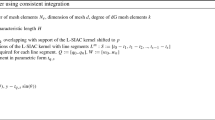Abstract
Most post-processors for boundary element (BE) analysis use an auxiliary domain mesh to display domain results, working against the profitable modelling process of a pure boundary discretization. This paper introduces a novel visualization technique which preserves the basic properties of the boundary element methods. The proposed algorithm does not require any domain discretization and is based on the direct and automatic identification of isolines. Another critical aspect of the visualization of domain results in BE analysis is the effort required to evaluate results in interior points. In order to tackle this issue, the present article also provides a comparison between the performance of two different BE formulations (conventional and hybrid). In addition, this paper presents an overview of the most common post-processing and visualization techniques in BE analysis, such as the classical algorithms of scan line and the interpolation over a domain discretization. The results presented herein show that the proposed algorithm offers a very high performance compared with other visualization procedures.















Similar content being viewed by others
References
Foley JD, van Dam A, Feiner SK et al (1997) Computer graphics. Addison Wesley, Reading
Farin G, Hoschek J, Kim M-S (2002) Handbook of computer aided geometric design. Elsevier, Netherlands
Aliabadi MH (2002) The boundary element methods, vol 2. Applications in solids and structures. Wiley, Chichester
Banerjee PK (1994) Boundary element methods in engineering. McGraw-Hill, London
Becker AA (1992) The boundary element methods in engineering: a complete course. McGraw-Hill, Cambridge
Beer G, Watson J (1995) Introduction to finite and boundary element methods for engineers. Wiley, Chichester
Beer G (2001) Programming the boundary element method. Wiley, Chichester
Beskos DE (1991) Boundary element methods in mechanics. Elsevier, Amsterdam
Brebbia CA, Telles JCF, Wrobel LC (1984) Boundary element techniques. Springer, Berlin
Brebbia CA, Domingues J (1989) Boundary element method: an introductory course. Computational Mechanics Publications, Southampton
Gaul L, Kögl M, Wagner M (2003) Boundary element methods for engineers and scientists. Springer, Berlin
Dumont NA (1989) The hybrid boundary element method: an alliance between mechanical consistence and simplicity. Appl Mech Rev 42(11):S54–S63
Souza RM (1992) O método híbrido dos elementos de contorno para a análise elastostática de sólidos. Master thesis to the Department of Civil Engineering of PUC-Rio, Rio de Janeiro
Dumont NA, Noronha M (1998) A simple scheme for the numerical evaluation of integrals with complex singularity poles. Comput Mech 22:42–49
Pape D, Banerjee PK (1987) Treatment of body forces in 2D elastostatic BEM using particular integrals. J Appl Mech 54:871–886
Gomes J, Velho L (2003) Fundamentos da Computação Gráfica. Edited by Série Computação e Matemática. ISBN: 978-85-244-0200-5 [Fundamentals of Computer Graphics]. http://www.impa.br/opencms/pt/publicacoes/col_matematica_e_aplicacoes/livro_fundamentos_da_computacao_grafica/index.html
Crisfield MA (1991) Non-linear finite element analysis of solids and structures. Wiley, Chichester
Levin Y, Ben-Israel A (2002) Directional Newton methods in n variables. Math Comput 71:251–262
Ragon SA, Gürdal Z, Watson LT (2002) A comparison of three algorithms for tracing nonlinear equilibrium path of structural systems. Int J Solids Struct 39:689–698
Noronha M, Pereira AMB, Müller AS (2005) An object-oriented computational platform based on Design Patterns for the BEM implementation. In: McMat2005: 2005 Join ASME/ASCE/SES conference on mechanics and materials, Baton Rouge
Booch G (1994) Object-oriented analysis and design with applications. The Benjamin/Cummings Pub. Co. Inc., Redwood City
Ammeraal L (1998) Computer graphics for java programmers. Wiley, Chichester
Mäntylä M (1988) Introduction to solid modeling. Computer Science Press, Rockville
Booch G, Rumbaugh J, Jacobson I (1999) The unified modeling language: user guide. Addison Wesley, Reading
Gaul L, Wagner M, Wenzel W (1998) Efficient field point evaluation by combined direct and hybrid boundary element methods. Eng Anal Bound Elem 21:215–222
Acknowledgments
The authors acknowledge the support of Brazilian agency FAPESP (Fundação de Amparo a Pesquisa do Estado de São Paulo—State of São Paulo Research Foundation).
Author information
Authors and Affiliations
Corresponding author
Rights and permissions
About this article
Cite this article
Pereira, A.M.B., Noronha, M.A.M. Post-processing and visualization techniques in 2D boundary element analysis. Engineering with Computers 26, 35–47 (2010). https://doi.org/10.1007/s00366-009-0134-5
Received:
Accepted:
Published:
Issue Date:
DOI: https://doi.org/10.1007/s00366-009-0134-5




